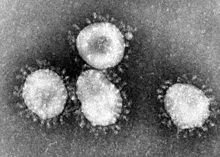|
|
| |
|
|
| |
|
|
|
|
| |
 |
| Transmission
electron micrograph of Avian coronavirus. |
Coronavirus
Coronaviruses are a group of related RNA viruses that
cause diseases in mammals and birds. In humans and
birds, they cause respiratory tract infections that can
range from mild to lethal. Mild illnesses in humans
include some cases of the common cold (which is also
caused by other viruses, predominantly rhinoviruses),
while more lethal varieties can cause SARS, MERS, and
COVID-19. In cows and pigs they cause diarrhea, while in
mice they cause hepatitis and encephalomyelitis.
Coronaviruses constitute the subfamily
Orthocoronavirinae, in the family Coronaviridae, order
Nidovirales, and realm Riboviria. They are enveloped
viruses with a positive-sense single-stranded RNA genome
and a nucleocapsid of helical symmetry. The genome size
of coronaviruses ranges from approximately 26 to 32
kilobases, one of the largest among RNA viruses. They
have characteristic club-shaped spikes that project from
their surface, which in electron micrographs create an
image reminiscent of the solar corona, from which their
name derives. |
|
The name "coronavirus" is derived from the Latin corona,
meaning crown or halo, and refers to how virions look
under electron microscopy (E.M.). They have a fringe of
large, bulbous surface projections looking like a crown.
This morphology is created by the viral spike (S)
peplomers, which are proteins on the surface of the
virus. They decide which cells the virus can infect.
Proteins that contribute to the structure of
coronaviruses are the spike (S), envelope (E), membrane
(M) and nucleocapsid (N). |
|
Diseases
Coronaviruses infect the upper respiratory and
gastrointestinal tracts of mammals and birds. Six
different strains of coronaviruses infect humans.
Coronaviruses are believed to cause many common colds in
human adults. The significance and economic impact of
coronaviruses is hard to assess. Unlike rhinoviruses
(another common cold virus), human coronaviruses are
difficult to grow in the laboratory. |
|
|
Examples |
- MERS-CoV
- Severe acute respiratory
syndrome coronavirus 2
|
|
|
|
|
|
|
|
|
|
|
|
|
|
|
|
|
|
|
Search Fun Easy English |
|
|
|
|
|
|
|
|
|
|
|
|
|
|
|
About
Contact
Copyright
Resources
Site Map |